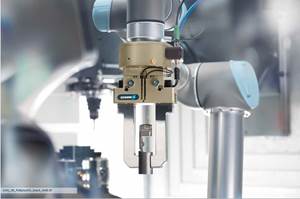Oil Drill Coupling Production Gets Automated
Sponsored by Okuma. A manufacturing cell combines lathes, gantry robot and conveyor system to enable automated production of oil drill couplings.
Share





The oil and energy business continues to grow. To reach deep oil reserves, drilling companies use a series of 40-foot lengths of pipe connected by couplings. The ID, OD and threads of those machined couplings must be accurate so that the pipes donÔÇÖt leak. Pipe leakage is especially problematic at significant depths.
Manufacturing couplings has traditionally been a manual process. Large companies that make couplings do so by manually loading pipe into older types of machining equipment. The heavy couplings are difficult to for operators to load and chip control during turning and threading operations is challenging.
Until recently, no one had developed an automated system dedicated to manufacturing couplings. Gayle Vollmer, Okuma director of technical resources, suggests the reason is because oil coupling producers are running at full capacity with their existing equipment and have little time for process development. ÔÇťThereÔÇÖs also a substantial cost factor in putting together a production cell for research and development,ÔÇŁ Mr. Vollmer says. ÔÇťPartners in THINC has not only the products and cell design expertise, but also experience helping shops that serve the oil industry.ÔÇŁ
In fact, Okuma and the Partners in THINC have created an automated coupling production cell that is scheduled to be available in August 2007.
Coupling Production Challenges
The oil industry uses two primary types of couplings: ÔÇťAPIÔÇŁ couplings for relatively shallow oil wells and ÔÇťpremiumÔÇŁ couplings for deep wells (used mostly for off-shore drilling). Demand for premium couplings has dramatically increased. After much research, Partners in THINC decided the time was right to develop a cell that offered a completely automated coupling production process to help meet that demand.
The cell was built and tested at the Partners in THINC facility in Charlotte, North Carolina. After experimenting with various tools, coolants, coolant pressures and machining practices, the Partners were able to solve the primary problem of chip accumulation during the turning and threading operations.
The automated manufacturing process begins with a FANUC overhead gantry robot that loads a double-length coupling blank in and out of the machines. This eliminates the need to have operators lift the heavy 9-5/8-inch-diameter workpieces. The gantry design also offers increased flexibility while saving valuable floor space. During machining, the blank is cut in half, eliminating a secondary sawing operation.
Using Kennametal, a Partners in THINC tooling partner, the roughing and finishing operations for coupling ID and OD are performed on a four-axis Okuma LOC-650 oil-country lathe. This lathe also performs the cutoff operation that separates the blank into two 10-inch-long coupling pieces. The pieces then move down a conveyor to an Okuma V80R vertical turning lathe (VTL). The vertical spindle orientation assists in evacuating chips during turning and threading operations. Both machines are fitted with a Schunk ÔÇťoil countryÔÇŁ chuck.
The chips produced during threading operations fall and flow away from the workpiece thanks to the V80R VTLÔÇÖs modified tooling adapter and ChipBLASTER high-pressure, high-volume coolant system. Coolant flow from precisely directed nozzles helps break up the chips and flush them out of the machine. After the threading operation, the workpiece is conveyed out of the cell and delivered to a measuring station, where a Marposs gage inspects its threads and diameters. The cycle time to turn, thread and deliver a completed coupling out of the cell is only 11 minutes.
This cellular production method allows complete OD turning in one operation. This helps meet high-precision threading requirements by avoiding the undesirable blend line that occurs with a two-part operation. In addition to increasing production speed, the cell eliminates the need for a 2-minute sawing operation.
Considering the increase in oil drilling activity, this timely Partners in THINC solution for automated production of drill couplings will have far-reaching effects in the oil industry.
Related Content
The Future of High Feed Milling in Modern Manufacturing
Achieve higher metal removal rates and enhanced predictability with ISCAR’s advanced high-feed milling tools — optimized for today’s competitive global market.
Read MoreOrthopedic Event Discusses Manufacturing Strategies
At the seminar, representatives from multiple companies discussed strategies for making orthopedic devices accurately and efficiently.
Read MoreLean Approach to Automated Machine Tending Delivers Quicker Paths to Success
Almost any shop can automate at least some of its production, even in low-volume, high-mix applications. The key to getting started is finding the simplest solutions that fit your requirements. It helps to work with an automation partner that understands your needs.
Read MoreBriquetting Manufacturer Tools Up for Faster Turnaround Times
To cut out laborious manual processes like hand-grinding, this briquette manufacturer revamped its machining and cutting tool arsenal for faster production.
Read MoreRead Next
AMRs Are Moving Into Manufacturing: 4 Considerations for Implementation
AMRs can provide a flexible, easy-to-use automation platform so long as manufacturers choose a suitable task and prepare their facilities.
Read MoreLast Chance! 2025 Top Shops Benchmarking Survey Still Open Through April 30
Don’t miss out! 91╩ËĂÁ═°Ňż╬█'s Top Shops Benchmarking Survey is still open — but not for long. This is your last chance to a receive free, customized benchmarking report that includes actionable feedback across several shopfloor and business metrics.
Read MoreMachine Shop MBA
Making Chips and 91╩ËĂÁ═°Ňż╬█ are teaming up for a new podcast series called Machine Shop MBA—designed to help manufacturers measure their success against the industry’s best. Through the lens of the Top Shops benchmarking program, the series explores the KPIs that set high-performing shops apart, from machine utilization and first-pass yield to employee engagement and revenue per employee.
Read More





















